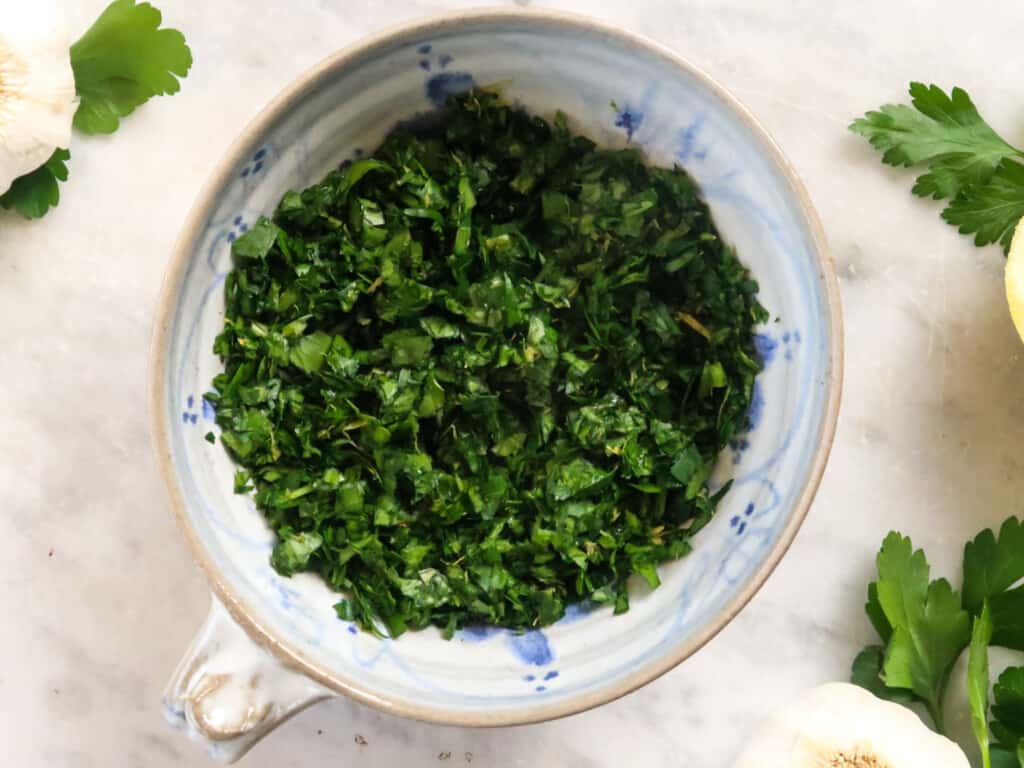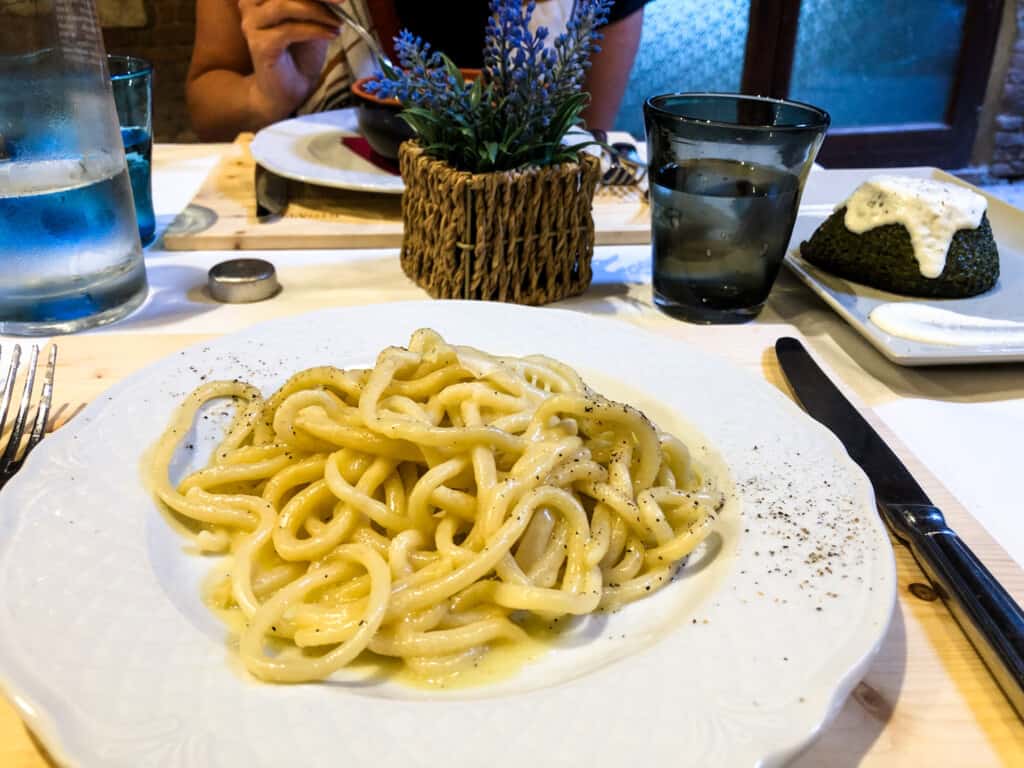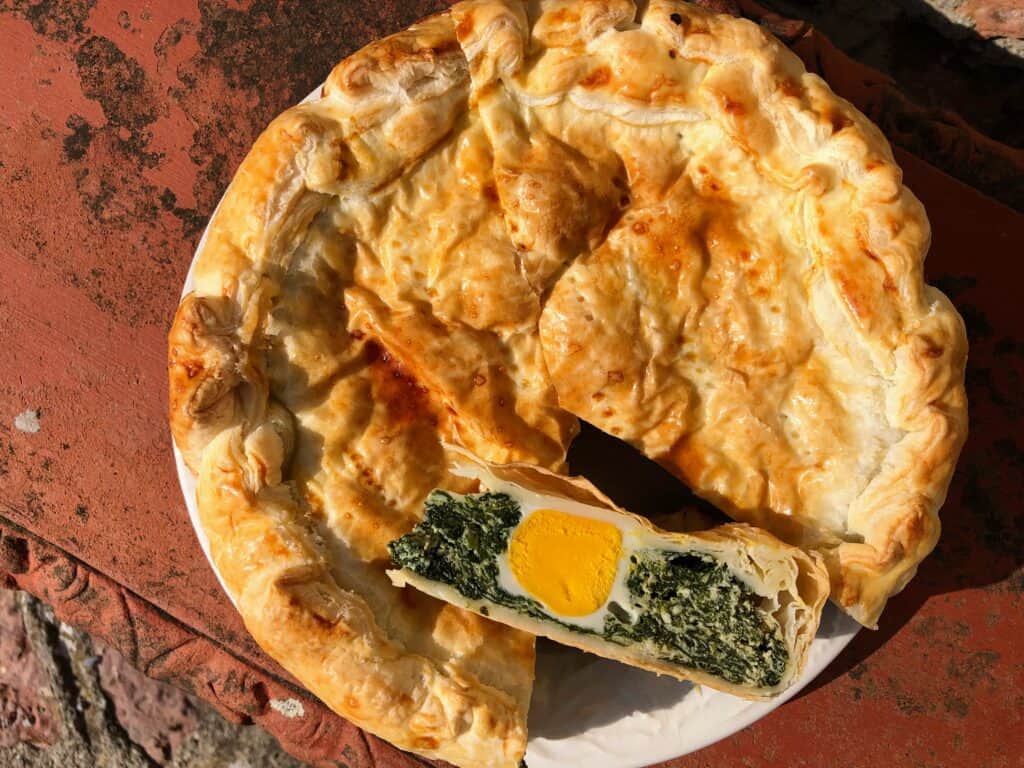The secret to adding a quick flavor boost to any heavy or everyday meal? Italian gremolata!
Gremolata is an easy and quick (it takes 5 minutes!) condiment that can be added to just about any recipe right before serving, bumping up the flavor profile of any dish and lightening up heavier meals.
In this article, I will share my Italian family’s recipe for gremolata including:
- how we use gremolata
- how to use this recipe as a formula to create other similar condiments
- my ultimate tips and tricks for using gremolata every day
Jump to Section
How To Pronounce Gremolata
Gremolata is pronounced greh-moh-lah-tah in Italian.
Listen to the pronunciation of gremolata:
What Is Gremolata?
Gremolata is a three ingredient dry topping or sauce used to finish a wide variety of foods such as grilled meats, pan seared fish and roasted vegetables in Italy.
Gremolata is made from finely chopped parsley, minced garlic and a zested lemon. The gremolata is then sprinkled over any kind of rich but simple dish (most traditionally on osso buco here in Italy where I live).
Gremolata Vs Salsa Verde

Gremolata is a dry, raw green sauce that is sprinkled over dishes as a finishing flavor boost to a wide variety of dishes.
Italian salsa verde is a liquidy, raw green sauce made with parsley and garlic but with the addition of capers, anchovies and olive oil. They can be used similarly, especially with grilled meats and vegetables.
Want to make your own salsa verde? Read Tuscan Salsa Verde Recipe + What To Eat It With and Italian Salsa Verde.
Gremolata Vs Chimichurri
Chimichurri is a raw runny green sauce made with shallots, red wine vinegar, chiles, cilantro and parsley originally from South America.
Just like gremolata, chimichurri is best used to accompany grilled meats.
Gremolata Ingredients
Parsley

Use 1.75 oz flat leaf Italian parsley (50 g), which is roughly ½ of a big bunch, cleaned and stalks removed. Don’t substitute curly parsley as it won’t create a silky sauce.
I don’t suggest using frozen parsley to make gremolata. If that is all you have, consider making Italian salsa verde or Tuscan salsa verde.
Garlic
Use 1 clove of garlic of your choice, white or purple. To learn more about garlic, the different types and how to chop it, read How To Peel Garlic – Best Easy & Fast Ways + How To Chop And Store It.
Lemon
Since we are using the zest of 1 lemon to make gremolata, be sure you have washed the lemon very well or that you are using organic produce.
Salt
Just a pinch to taste
How To Make Italian Gremolata

Remove the stalky stems from the parsley and clean it well. I like to use a salad spinner to dry it as best possible.

With a large kitchen knife, chop the parsley as finely as possible. This is key to an authentic and good gremolata. Transfer to a medium sized bowl.
Using a microplane, grate 1 clove of garlic into the chopped parsley.

Zest 1 lemon using the microplane. Add a pinch of salt

Mix all ingredients together well, using your hands if helpful to break up the zest and garlic pulp.
Serve immediately or keep in an airtight container in the refrigerator for up to 5 days.
Notes and Tips For Making Gremolata

- Use flat-leaf Italian parsley which has much better flavor and texture than curly parsley for this gremolata recipe.
- You can use a food processor to cut the parsley but it can easily bruise the leaves and turn your chopped parsley into a paste from one second to the next. Chopping my hand is the safest and easiest way to prevent this from happening.
- The secret ingredient to any good gremolata is to chop the parsley as finely as possible. Use a large kitchen knife and mince the parsley.
- I sometimes find it difficult to mix all the ingredients together because the garlic turns into a small wad. You use hands if need be and really make sure you have a uniform mixture.
- Keep a small bowl of gremolata in the fridge, switching up the herbs and citrus you use. Offer it to kids when they find a particular dish boring or uninteresting or add it to heavier beef stews and braises for a light and refreshing finish.
Gremolata Variations & Substitutions

Gremolata should really be used as a formula, a ratio for any herb and citrus combination that you like and pairs well with other foods that you are serving. Use these herb combinations as inspiration but get creative with flavors and using more than one herb at once:
- Cilantro + lime zest and garlic
- Basil + lemon zest and garlic
- Parsley + lemon zest and garlic
- Mint + orange zest and garlic
Good To Know: Traditional gremolata is generally dry but you can add a drop of extra virgin olive oil or lemon juice to thin it out and make it more of a spoonable, runny sauce if you like. I personally prefer to keep it dry but everyone has their own preference. See what fits your family best!
How To Use Gremolata

There are so many ways to use gremolata, which is why it’s one of my favorite condiments to keep on hand in the refrigerator.
Here are my family’s favorite ways to use Italian gremolata:
- on grilled or baked fish
- on cooked beans
- on stews or braises
- on roast roasted, grilled or baked chicken
- on veal shanks (osso buco)
- on hummus or mixed into yogurt for a vegetable dip
- in garlic bread
- on steak
- on sausages
- on pasta or rice
- in olive oil with bread
How To Store Gremolata
Store leftover gremolata in an airtight container for up to 5 days. It does not freeze well.
Italian Gremolata
Ingredients
- 1/2 bunch Italian flat leaf parsley cleaned and large stems removed (about 1.75 oz or 50 g)
- 1 clove garlic
- zest of 1 lemon
- pinch salt
Instructions
- Remove the stalky stems from the parsley and clean it well. I like to use a salad spinner to dry it as best possible.
- With a large kitchen knife, chop the parsley as finely as possible. This is key to an authentic and good gremolata. Transfer to a medium sized bowl.
- Using a microplane, grate 1 clove of garlic into the chopped parsley.
- Zest 1 lemon using the microplane. Add a pinch of salt
- Mix all ingredients together well, using your hands if helpful to break up the zest and garlic pulp.
- Serve immediately or keep in an airtight container in the refrigerator for up to 5 days.
Notes
- Use flat-leaf Italian parsley which has much better flavor and texture than curly parsley for this gremolata recipe.
- You can use a food processor to cut the parsley but it can easily bruise the leaves and turn your chopped parsley into a paste from one second to the next. Chopping my hand is the safest and easiest way to prevent this from happening.
- The secret ingredient to any good gremolata is to chop the parsley as finely as possible. Use a large kitchen knife and mince the parsley.
- I sometimes find it difficult to mix all the ingredients together because the garlic turns into a small wad. You use hands if need be and really make sure you have a uniform mixture.
- Keep a small bowl of gremolata in the fridge, switching up the herbs and citrus you use. Offer it to kids when they find a particular dish boring or uninteresting or add it to heavier beef stews and braises for a light and refreshing finish.




